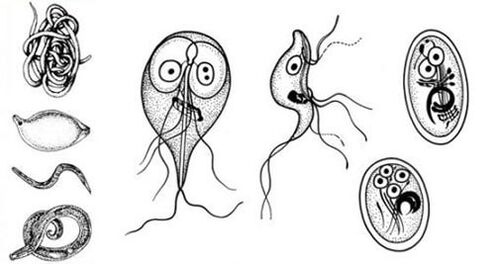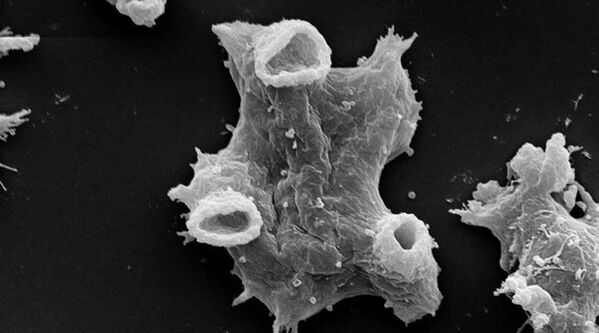It is common to refer to parasitic protozoan microorganisms those parasites that are constantly in the human body and feed on its "liquids". They have nothing to do with worms, but some unicellular parasites can reach large sizes.

They are completely independent organisms, although they have lost the digestive vacuole, which is caused by their lifestyle.
Classes of parasites
Representatives of different organisms can be classified as follows:
- Sarkodie- negligence and amoebae.
- spore- Toxoplasma Plasmodium.
- who- balantidium
- flagella- Leishmania, Trichomonas, Trypanosomes and Giardia.
These organisms are one of the first simple organisms to appear on the planet. Their basic structure and working functions can cause the development of fatal diseases. The list contains common representatives of protozoan parasites, but there are many others.
Impact on the body
Although these parasites are called protozoa, they have a very negative effect on the human body, causing serious diseases.
Sarkodie
dysenteric amoeba (Entamoedahistolytica).The parasite is most common in hot places. A feature is the lack of skeletal and shell formations. She has legs for movement. It can form cysts in the human body.
It often causes amoebiasis when the intestinal wall is affected. A person has loose stools with blood. Diagnosing such an amoeba is quite difficult. It is a very dangerous parasite.
Negleria Fowler.Man is the intermediate host. The site of localization of the parasite is usually the brain.
Causes amoebic meningoencephalitis, which is often fatal.
flagella
Trichomonas (Trikmonasvaginalis).The disease appears in men almost asymptomatically, only in the form of carriage. In women it manifests itself with pronounced signs of inflammation: profuse discharge with an unpleasant odor, itching and pain in the lower abdomen.
This simple parasite, as a rule, is sexually transmitted, but it also happens through contact-family. Infected women can infect their baby during childbirth.
Giardia.These microorganisms parasitize the gastrointestinal tract. The impact on the body consists of cystic transport for many years, but the disease persists in a mild form. Rarely, it becomes chronic. By the way, they are not afraid of toxic substances and ultraviolet radiation.
spore
Leishmania (Leishaniaspp).This species is localized in almost all human organs and eventually destroys them. Causes a serious disease - visceral leishmaniosis. In their habitat, an open ulcer forms, which constantly rots. It is difficult to treat and often requires surgery.
Plasmodium and malaria.Localized in blood plasma, erythrocytes and liver cells. The worst thing is that these simple organisms destroy red blood cells. Leads to tropical and perennial malaria. It can seriously damage the kidneys and destroy the nervous system.
Toxoplasma.It affects the lymph nodes and small intestine. Toxoplasmosis often develops, which is very dangerous for pregnant women. In the initial stage of infection, it mimics a viral infection.
who
Intestinal balantidia (Balantidiumcoli).It usually affects the large intestine, especially the intestines. This is a fairly large single-celled organism that easily enters the bloodstream.
They do not cause much harm to the body, but ulcers can appear in the intestines.
Symptoms and diseases caused by protozoan parasites
Currently, a number of pathogens have been identified that cause the following diseases:
- Giardiasis.
- Malaria.
- Leishmaniasis.
- Trichomoniasis.
- Cryptosporidiosis.
- Balantidiasis.
dysenteric ameba
Infection occurs through food and household items.
Symptoms that appear with a slight course of the disease:
- bounce.
- Abdominal cramping pain.
- Constipation is replaced by diarrhea.
Average severity of disease course:
- The symptomatology increases within 10 days.
- There is weakness and loss of appetite.
- Bloody mucous stools.
- Abundant feces.
When the disease becomes chronic, the weight is significantly reduced.
Pathologies caused by this parasite:
- Peritonitis.
- Amebic appendicitis.
- Dysentery.
- Lung and liver abscesses.
- Extremely rare amoebic hepatitis and brain abscess.
- Cutaneous amoebiasis with the development of ulcers and erosions.
With a rapid onset of the disease, even a fatal outcome is possible in debilitated people.
Naegleria fowleri (Naegleria fowleri)

You can become infected with this parasite when swimming in a pond as well as in the air.
The disease always begins with the appearance of acute symptoms:
- Loss of smell and sense of taste.
- Headache and weakness.
- Nausea and vomiting.
- Loss of movement coordination.
- Pulmonary edema may develop.
- Hallucinations and convulsions.
Diagnosing the disease is very difficult, so it often ends with the death of the patient.
Negleria causes the following pathologies:
- Amebic meningoencephalitis.
- Negleriasis.
- Destroys the brain.
- A person often falls into a coma.
The infection is often fatal.
lamblia
Diseases occur without pronounced symptoms. The infection is transmitted by unwashed fruits and dirty hands.
Typical symptoms:
- Increased saliva.
- Discomfort in the abdomen.
- Loss of appetite and vomiting.
Sometimes there is a green foamy stool and a strong odor.
Diseases caused: giardiasis and various intestinal dysfunctions.
Leishmania
Infection is caused by mosquitoes.
Appears with severe symptoms:
- Enlargement of the spleen and liver.
- High temperature rise.
- Feverish conditions.
- Weakness and pallor of the skin.
- Hemorrhages in the skin.
- Problem with heart activity.
- Anemia and severe weight loss.
Sometimes edema and pneumonia can combine.
This parasite leads to cachexia, decreased muscle tone, impotence and heart failure.
Trichomonas
Infection occurs with debris and hygiene items. Symptoms are mostly absent, but occasionally appear.
For men:
Discomfort while urinating.
- There is blood in the semen.
- White download.
Among women:inflammation of the cervix and vagina.
The infection is very dangerous for pregnant women, as it can cause premature birth.
Plasmodium and malaria
Mosquito bites lead to infection.
Plasmodium vivax.Symptoms depend on the stage of the disease:
- Chills for up to 3 hours - muscle and joint pain, liver pain.
- Fever for about 12 hours - temperature up to 40 degrees, decrease in pressure, shortness of breath and tachycardia.
- Strong phase of sweating - a sharp drop in temperature with the release of sweat, muscle weakness and hypotension.
A three-day malaria may develop and spontaneous recovery may occur. There may be an enlarged spleen, anemia and sometimes even jaundice.
Plasmodium malaria.There are morning and evening fever attacks. There are also signs of three-day malaria. It can cause the development of nephrotic syndrome, which is difficult to treat.
Plasmodium oval.Fever attacks come only in the evening. The disease proceeds quite easily, but the liver may grow slightly.
Toxoplasma
The ways of infection are quite wide. You can be infected by half-cooked meat, dirty products, blood transfusions and skin cuts. By the way, the infection of a pregnant woman is often transmitted to the fetus.
In the presence of an acute form of the disease, the following symptoms appear:
- Significant enlargement of the liver and spleen.
- Signs of jaundice.
- Redness of the skin.
- Typical symptoms of meningitis and encephalitis.
- The lymph nodes are enlarged.
In chronic form:
- High temperature for a long time.
- Muscle and bone pain.
- In women, the menstrual cycle is interrupted.
- There are headaches and irritability.
In addition, there may be problems with the thyroid gland and kidney failure.
Infection with parasites of this class threatens the emergence of many diseases:
- Oligophrenia.
- Toxoplasmosis.
- epileptic seizures.
- Inflammation in the retina.
- hepatolienal syndromes.
Rarely, however, lymph node sclerosis occurs.
Intestinal balantidia
You can catch the parasite through unboiled water, dirty hands and fruit.
Signs of infection:
- Prolonged diarrhea, with pus and blood.
- Abdominal pain syndrome.
Balantidia leads to the development of peritonitis, organ abscesses and perforation of the intestinal wall.
Conclusion
Infection with protozoa is very similar to infection with viruses. By definition, they are not considered worms, although they cause great harm to human health.
Infection with protozoan parasites can lead to death, so when typical symptoms appear, you should seek medical help immediately. Self-medication is strictly prohibited.






































